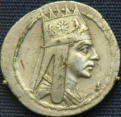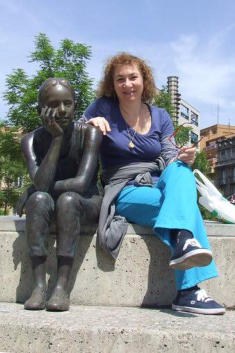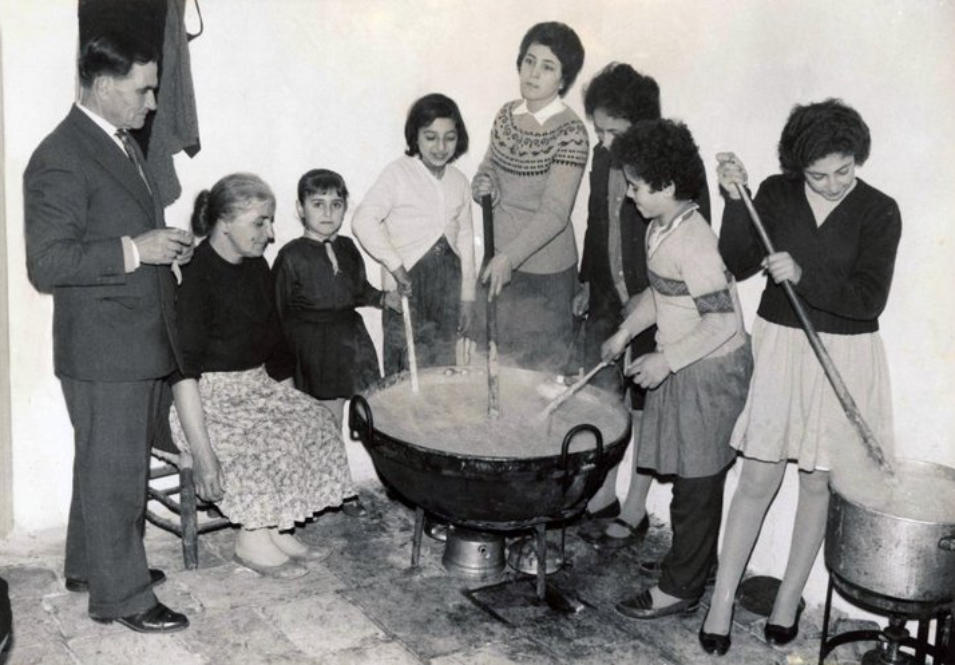


I
remember
Artin
el-Khal
and
how
he
used
to
take
bottles,
clean
them
up,
and
put
sand
and
wooden
crosses
inside, creating beautiful pieces of art.
And
who
can
deny
it?
He
and
his
wife,
Anna
el-der
dereh,
made
the
best
"basterma"
and
"sujok"
in
Jerusalem.
And
we
never
worried
about
the
garlic
or
the
smell
of
the
garlic!
Reading
the
pages
of
the
website
brough
up
one
memory
that
had been locked up for over 40 years.
This
was
1967,
during
the
Six
Day
War.
The
Kankachian,
Toumayan,
Hovagimian
and
Ra'i
families
had
been
by
Artin
el-
khal to go downstairs to seek shelter from the war.
Whenever
we
heard
an
explosion,
Artin,
who
had
a
wonderful
sense
of
humor,
would
turn
to
us
and
comment:
"They've hunted another rabbit."
After
a
couple
of
days,
we
heard
some
commotion
outside
and
my
father
crept
up
the
stairs
and
peeped
through
the
curtains
of
the
window,
across
at
the
Agoump.
He
was
well
hidden:
because
of
the
plants
in
the
window,
no
one
could
see
him.
He
saw
Jewish
soldiers
calling
on
people
to
put
up
a
white
flag,
as
a
sign
of
surrender.
All
my
father
could
find
was
one
of
my
youngest
sister's
white
cloth
diapers. So, he hung it on the window, and ran back to the room.
He
told
us
what
he
had
done.
Just
then,
we
heard
loud
banging
on
Artin's
door.
Without
wasting
a
second,
Artin
picked
up
what
looked
like
a
machette,
began
sharpening
it
[I
think
it
was
a
cleaver
which
he
used
to
cut
up
the
meat
for
the
"basterma"
and
"sujok",
and
ordered
us
girls
-
there
were
seven
of
us
there
-
to
get
under the bed.
He
covered
us
with
a
blanket
and
told
us
to
be
quiet
and
pretend
to
be
playing
hide and seek.
He
then
stood
behind
the
door
and
told
the
men
around
him,
"I
will
not
allow
any
soldier to touch those young girls - over my dead body."
The
soldiers
were
again
shouting:
so
Artin
crept
up
the
stairs
and
found
a
sheet
which he hung outside the window.
I have never told this story to anyone else.
But
the
story
does
not
end
there.
One
Armenian
family
living
close
to
"Haqouret
el
bashashteh"
could
find
nothing
more
suitable
than
some
old
underwear
to
use
as
a
white
flag.
It
did
not
amuse
the
soldiers:
they
considered
it
an
insult
and
kept
screaming at the family to take it down!
Easter
in
Jerusalem
used
to
keep
the
children
busy,
boiling
eggs
and
coloring
them,
our
favorite
color
the
ones
yielded
by
onion skins which are boiled along with the eggs.
The
eggs
were
handed
out
to
the
children
who
delighted
in
cracking
them
against
one
another.
You
held
the
egg
with
the
four
fingers
of
your
right
hand,
showing
just
the
tip
of
the
sharp
edge.
Your
competitor
did
the
same,
then
whoever's
turn
it
was,
would
peck
at
the
other's
egg.
And
whoever
cracked
the
other's
egg,
won.
But
if
your
egg
cracked,
you
got
another
go,
by
reversing
it
in
your
hand,
and
trying
to
crack
your
opponent's with the other end.
But
Easter
was
more
than
eggs.
The
kaghakatzis
baked
"ka'ek"
and
"ma'moul,"
pastries
filled with dates and crushed walnuts, and sprinkled with sugar.
The
tradition
was
apparently
a
carryover
from
the
Armenians'
pagan
past
when
our
people
were
animists,
worshipping
nature
and
all
its
manifestations,
particularly
the
sun
and fire.
The
Armenians
of
Jerusalem
would
celebrate
ate
arrival
of
spring
by
baking
the
"ka'ek"
which represented the sun while the "ma'moul" represented fire.
Later,
with
the
advent
of
Christianity,
"ka'ek"
came
to
represent
the
crown
of
thorns
placed
on
the
head
of
Jesus,
and
"ma'moul"
the
water
and
vinegar
the
Roman
soldiers
gave
him to drink.
The
girls
used
to
go
to
the
empty
lot
in
the
Armenian
Quarter
called
Hakourt
El
Bashashteh
to
collect
square
stones
for
the
game
which
sometimes lasted for hours.
It
was
only
a
few
meters
away
from
where
we
all
lived,
but
our
parents did not look favorably on us playing in the streets.
There
would
be
five
stones.
We
would
throw
one
in
the
air,
then
pick
one
from
the
ground,
quickly
followed
by
another,
trying
to
juggle
the
five,
in
one
manouever
which
looked complicated but was actually quite easy.
When
there
were
boys
around,
we
used
to
play
the
"tin
game",
which
posed
some
problems
because
it
was
hard
to
find
an
empty
or
discarded
tin:
people
had
not
yet
got
used to eating food from tins.
The
game
started
with
someone
volunteering
to
lead.
He
or
she
would
throw
the
tin
as
far
as
he/she
could,
and
the
other
players
would
seize
the
opportunity
to
find
a
hiding
place.
Sometimes,
we
would
sneak
into
a
nearby
house.
No
one
had
locks
on
their
front
doors in those days.
The
leader
had
the
task
of
locating
us.
If
he
or
she
succeeded
to
find
one
of
us,
he/she would run to the tin and click it: then the "loser" would take on the job of detective.
During
a
break
in
the
game,
we
would
chat
and
gossip
and
exchange
jokes,
and
make
fun of the passersby.
One
of
us
would
be
standing
guard
to
watch
out
for
the
approach
of
a
parent.
If
one
was
sighted,
his
or
her
child
would
scamper
home
at
once
before
being
caught
out
and
given a tongue-lashing.
With
so
many
fruit
trees
in
the
neighborhood,
bearing
all
those
succulent
trees,
we
had a whale of a time raiding the orchards and picking grapes, pomegrenates, berries.
If the branches were too high to reach, we used a fireman's lift to hoist one of us up.
One
game
we
were
absolutely
forbidden
to
attempt
was
playing
cards.
But
we
circumvented
that
ruling:
we
would
climb
up
a
water
pipe
and
meet
at
the
top
of
the
roof
of one of the houses in the neighboorhood.
Once the game was over, we would hide the cards behind a tile or stone.




























